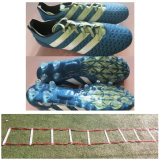The purpose of this study was to describe the epidemiology of Korean collegiate injuries during 2015. Collegiate student-athletes(n=167) in six sports (badminton, baseball, basketball, rugby, taekwondo, and volleyball) participating in all practices and games during pre-season, in-season, and post-season were tracked via the injury surveillance system(rate, location, type, and cause of musculoskeletal injury). Injury rate for 1000 athlete-exposure(AE) and 1000 time-exposure(TE) were calculated with 95% confidence intervals(CI). We captured a total of 961 injuries, a rate of 19.29/1000 AE(95% CI=18.07, 20.51) and 0.16/1000 TE(95% CI=0.15, 0.17). Commonly injured body locations were knee(17.5%, n=168), thigh(16.1%, n=155), ankle(12.1%, n=116), and finger(8.4%, n=81). Injuries were mostly diagnosed as contusion(40.1%, n=385), ligament sprain(21.1%, n=203), and laceration/abrasion/skin injury(13.5%, n=130). Common causes were contact with another athlete(44.6%, n=429), contact with moving object (12.7%, n=122), overuse/atraumatic(11.9%, n=114), and contact with non-yielding object(9.4%, n=90).
PURPOSE This study aimed to identify movement pattern differences in the running of youth soccer players with and without lateral ankle sprain (LAS) histories. METHODS A total of 12 participants were recruited and assigned to the LAS group or the control group. All participants were assessed for anthropometric data, and they filled in the subjective ankle function questionnaires. Then, reflective markers were attached to their bodies, and they were instructed to run at the preferred speed on the 9-m runway thrice. 3D joint angles for ankle, knee, and hip joints were exported, and their mean values and 95% confidence intervals were calculated. Ensemble curve analysis was conducted to compare running kinematics between the groups. RESULTS The LAS group exhibited fewer dorsiflexion angles and more inversion angles compared to the control group. Excluding the dorsiflexion deficits and more inverted ankles, there were no significant differences between the groups. CONCLUSIONS Although the ankle kinematic patterns found in this paper are not considered LAS risk factors, it will be able to identify precise LAS risk factors with prospective design (e.g., lower extremity movement patterns) as well as intrinsic risk factors.

Purpose The purpose of this study was to investigate the lower extremity muscles activity during forward side step by soccer field ground types. Methods Fifteen elite high school soccer players participated in this study. Muscle activation patterns were recorded at 2000 Hz during forward side step task. Surface EMG of the tibialis anterior(TA), soleus(SOL), medial gastrocnemius(MG), lateral gastrocnemius(LG), peroneus brevis(PB) muscle was recorded, and the root mean square of the EMG was normalized, using a maximum voluntary isometric contraction(%MVIC). One-way repeated ANOVA was used for comparison among three soccer field ground types(natural grass, artificial turf, hard ground). Results Artificial turf displayed greater soleus and peroneus brevis activities compare to natural grass during forward side step task. Conclusions The relationship between increased soleus and peroneus brevis activation and greater incidence of injury in artificial turf versus natural grass requires further study. Soccer players routinely training on artificial turf for prolonged periods should be carefully monitored.


PURPOSE This study aimed to: 1) compare the differences in static lower-extremity alignment (SLEA) between female ballet dancers (BD) and non-ballet dancers (NBD); 2) investigate the differences among gesture leg (GL) and supporting leg (SL) in BD and dominant leg (DL) in NBD; and 3) compare limb asymmetry between groups. METHODS Twenty-nine female BD and 20 NBD were recruited for this study. The quadriceps, tibiofemoral, rearfoot, and genu-recurvatum angles, tibial torsion and varum, and navicular drop height were measured. An independent t-test was conducted to compare SLEA and limb asymmetry between groups. One-way analysis of variance with Bonferroni post-hoc tests were performed to determine the differences among the GL, SL and DL. RESULTS BD showed lower quadriceps and rearfoot angles, less tibial varum and navicular drop, and greater tibiofemoral angle (p<.005) than NBD. BD showed less quadriceps angle asymmetry but greater tibial torsion asymmetry (p<.01) than NBD. GL and SL in BD showed differences in quadriceps, tibiofemoral, rearfoot angle, tibial torsion and navicular drop compared to NBD. CONCLUSIONS Repetitive dance movements can transfer varying forces to the GL and SL, potentially contributing to SLEA asymmetry. An intervention strategy that can reduce SLEA asymmetry in BD is needed, as is the identification of elements of ballet training that contribute to maintaining a normal SLEA.